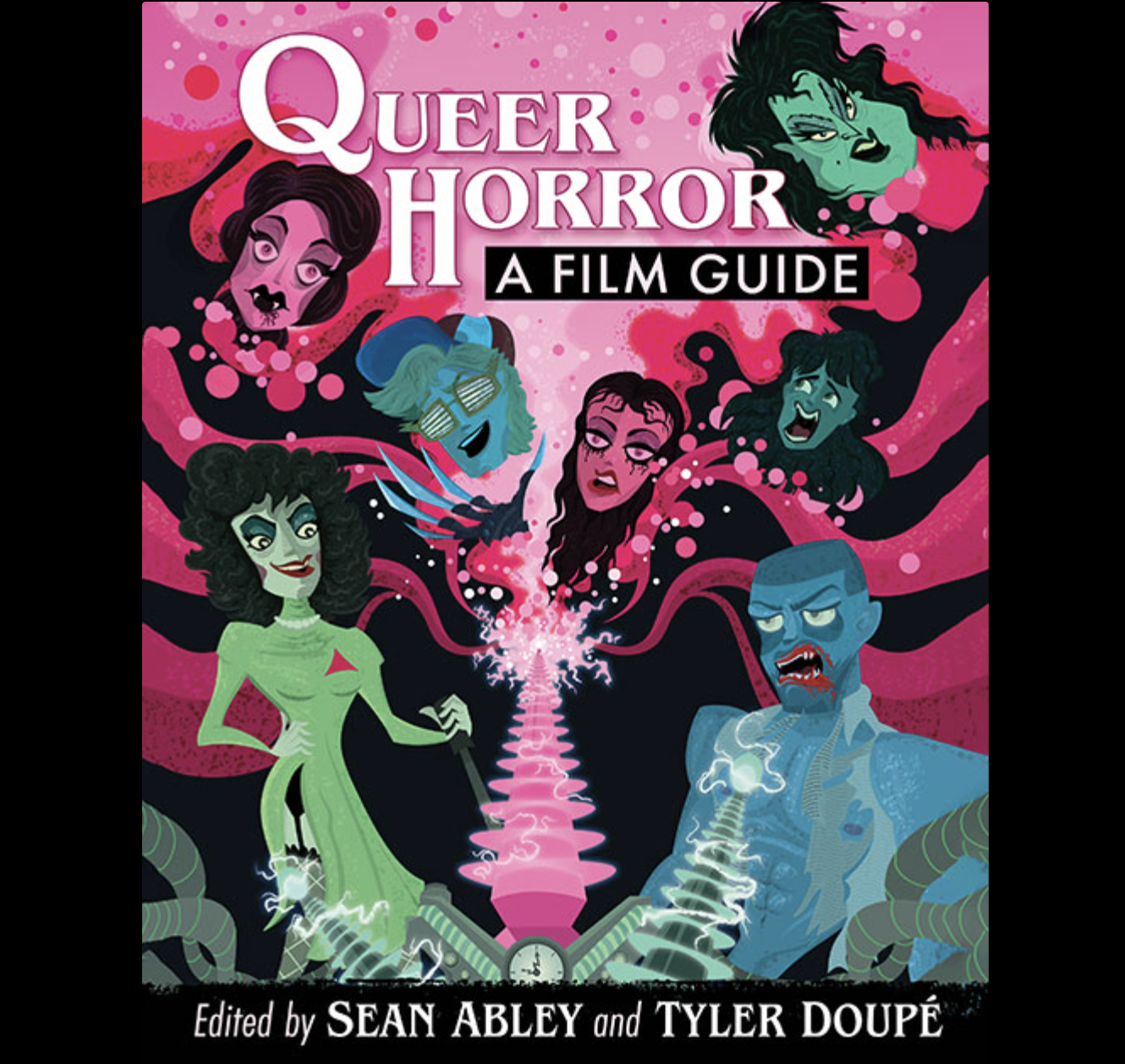I first met Sean Abley in the early-90s, as participants in the Chicago theatre scene. He had a theatre company called The Factory Theatre, where he put on shows he wrote and also directed. He was a phenom, and these shows (Bitches, Santa Claus Conquers the Martians: The Musical, Attack of the Killer B’s, Nuclear Family) were popular long-running events. I saw Bitches probably four times. A lifelong horror fan, he had a now-defunct blog on Fangoria called Gay of the Dead where he wrote about queer horror films (Sean is now putting that archive onto his Gay of the Dead patreon). He’s a successful screenwriter and film/television producer, and in 2014, he created the Queer Horror panel at San Diego Comic-Con. In 2018, he founded the Desert Playwrights Retreat, the first retreat for LGBTQ playwrights. He loves encyclopedias, and got the idea to create a queer horror anthology about nine years ago.
Queer Horror: A Film Guide, co-edited by Abley and Tyler Doupé, a staff writer at Dread Central, will be published in July by McFarland Books. A labor of love, the anthology has almost 1,000 capsule reviews written by Abley and seven other writers (Calpernia Addams, Doupé, Molly Henery, Alan Kelly, Daniel W. Kelly, Brian Kirst, and Michael Varrati). The time span is vast: films from the 1930s up to films made in 2021. “Queer horror” as a genre is a relatively new phenomenon, but queerness has been present in horror films from the start, and the selection of films reflect this rich history. In the pre-internet days, you had no idea there were others out there like you. Abley loved gory films as a child. The cliche is that a gay boy will love Wizard of Oz, not the gory splatter of exploitation filmmaker Herschell Gordon Lewis’ oeuvre, and so Abley felt very alone. Then came the internet, and the happy discovery that there was a huge community of gay people who loved slasher films, horror films, all of it.
Queer Horror: A Film Guide put it all into one place. The writers don’t play it safe. They include “problematic” films like 1983’s teen slasher Sleepaway Camp, which features a trans villain, and remains controversial today. Especially interesting are the entries on films that generated firestorms of controversy in their own time, films like William Friedkin’s Cruising, in which Al Pacino plays a cop going undercover in the gay leather-bar scene in 1980’s New York City, and Paul Verhoeven’s noir-camp Basic Instinct, with Sharon Stone as a glamorous lesbian murderer. Both films were the subject of organized protests at the time of their releases (and protestors actually interrupted the filming of Cruising on a number of occasions). In an era when there was almost no positive representation of gay people on film, Cruising and Basic Instinct were seen as threatening and dangerous. Has time been kind to these films? Removed from their historical context, sometimes things look different. Karina Longworth devoted an entire episode of her celebrated podcast You Must Remember This to Basic Instinct. Abley and his writers address these thorny issues in entry after entry, making for a fascinating read. It was a pleasure to talk about the book with Sean over Zoom. I asked him to pull out a couple of films from the book to discuss (not “the usual suspects”).
Horror is fun. All are welcome.
This might be impossible to answer but what drew you to horror?
I’ve wrestled with this. If you are a young gay kid, you are left with a lot of free-floating trauma. With horror, the trauma has a beginning, a middle, and an end. Being bullied at school is unending, so regardless of whether or not the representation is positive, there’s an experience in horror you can take comfort in. I was surprised when I learned other gay guys liked gory movies. I felt like I was weird not because I was gay, but because I was gay and I liked Herschell Gordon Lewis movies. I was like, What’s wrong with me? Am I not a good gay guy?
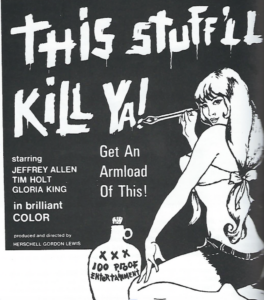
Herschell Gordon Lewis’ THIS STUFF’LL KILL YA 1971
What was the process writing this book?
When I started writing my Gay of the Dead blog for Fangoria back in 2009, queer horror films were just starting out as a genre. I was one of the few people working in that corner of entertainment journalism. I’m a fan of Danny Peary’s cult movie books (Cult Movies: The Classics, the Sleepers, the Weird, and the Wonderful), and I thought wouldn’t it be great if there was some version of those books for queer horror? I reached out to a handful of people who were bloggers, mostly. At first the book was just going to be gay content and then Sleepaway Camp (1983) came up and I thought, “I’m not going to include Sleepaway Camp because it’s trans and not gay-specific?”
And so it ballooned.
I mean, Jesús Franco made 100 lesbian vampire movies.
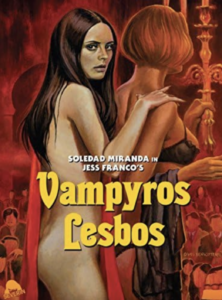 Jesus Franco’s VAMPYROS LESBOS (1971)
Jesus Franco’s VAMPYROS LESBOS (1971)
Is there any other kind?
Exactly. I brought on Molly Henery and Calpernia Addams for femme and trans representation, not that they had to write specifically about those subjects. This process has taken about eight or nine years. I think the most important thing for me is it’s eight writers with different styles. I wanted it to be a chorus of voices.
I’ve been thinking a lot about gatekeepers. I have conflicting feelings about lists, which are by definition exclusionary. And yet I relied on lists as a kid and young adult, because I used them to educate myself. Do you have any thoughts on the concept of gatekeepers?
I see myself more as a curator and archivist than a gatekeeper, but I totally understand what you’re saying. It makes me think about how every Halloween, every list of horror movies is written by people who aren’t really into horror, and it’s always the same list. The perennials are A Nightmare on Elm Street Part 2: Freddy’s Revenge (always first on the list), Sleepaway Camp, The Hunger, Fright Night, Dracula’s Daughter, Rocky Horror Picture Show, Rope. These films are a great foundation for the genre, and wonderful gateways for folks whose knowledge of queer horror is limited. The book honors those, but also provides hundreds more titles for those interested in a deeper dive. Our book is the beginning of the conversation for so many movies that are never on those lists.
There’s a spectrum of perspectives in the book on judging things from the past by today’s standards.
I look at it this way. Sometimes our favorite things have an expiration date. That doesn’t mean it was bad we liked them then, it doesn’t mean it’s bad we still like them, it doesn’t even mean it’s bad we’re apologists for them. It just means the material wouldn’t fly today. Or the opposite. When Cruising (1980) and Basic Instinct (1992) first came out, people lost their minds because we were so starved for representation that every terrible portrayal was another nail in our coffins. They look very different now.
You dealt with this so well in the entry on Cruising.
We can’t pretend Cruising didn’t land how it landed. But we’re not the same people we were even 5 minutes ago. I could not find a gay man who doesn’t love Basic Instinct now. I’m 58 years old. I was alive when Basic Instinct was protested. I remember why we weren’t supposed to like it. I re-watched for the book and I love it. The same with Cruising. William Friedkin wasn’t in the business of making gay indie films to play in arthouses. He made Cruising for the general population and he made it with a movie star. His movies opened wide in every theater in the country, and he thought a movie about a serial killer stalking gay men in leather bars was a thing people wanted to see. A miscalculation on his part. Even though the physical movie is preserved in amber, the experience of watching it is not. And so we have to give ourselves, and the film, and the filmmaker’s intentions, all the grace in the world.
Let’s talk about John Waters. To me, he’s like Dolly Parton in that I actively dread his death.
John Waters’ work clearly falls under the umbrella of the queer horror genre and so of course we had to include him. I don’t think there’s a more canny filmmaker alive than John Waters. If you’ve read his essay collections, Shock Value and Crackpot, and watch his films in order, you see a meticulous ramp-up to Divine eating dog shit in Pink Flamingos (1972) and then a denouement after that. It is so methodically plotted out film to film. Divine eating dog shit was a stunt, yes, but the moment was absolutely necessary. It took some time for the world to catch up with who Waters actually is but I think he was okay with people having the perception of him that they did.
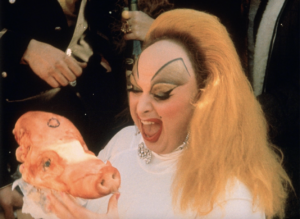 Divine in PINK FLAMINGOS (1972)
Divine in PINK FLAMINGOS (1972)
Can we talk about the X-rated/gay horror continuum?
Back in the day, one of the only places where gay men saw themselves in loving relationships was pornography. I have to give credit to gay porn archivist Liz Purchell for pointing me in the direction of early gay horror films like Sex Demon (1975). These people didn’t consider themselves pornographers, they considered themselves filmmakers. They were trying to do something that would transcend the grindhouses where you would see this stuff. I think a lot of people will be surprised at the amount of X-rated stuff in the book. As queer people, we have different rules about the media we consume and how we archive it. It’s such a part of our history that to leave it out of the book felt negligent. It’s also just fun and titillating. It’s important to remember horror movies are fun. The fact that there’s a gay porn Exorcist homage … I laugh just saying it.
I had never heard of Best Deaths.
How do I explain Best Deaths? Best Deaths is a faux gay snuff film made-to-order website. (It was once BestDeaths.com and is now Dark Angels). What you do is you contact them and say: “I want to see two guys, one in a cop uniform, the other dressed as a surgeon, and I want one to strangle the other one to death, and then have him come back alive, and then they have a knife fight.”
Who directs these films?
Victor Alfaro, the guy who runs the website. The content is violent, no allegory or homage, and it pushes the boundaries of things like intergenerational relationships. The cast is usually young.
There’s something almost tender about this whole idea. A whole company geared towards filming the fantasies of anonymous people out there who want to see whatever it is for whatever reason. People are lonely. This fulfills a need.
I won’t cast aspersions on the audience, because I watched A Serbian Film and enjoyed it and that movie is so depraved, so what does that say about me? I want to be careful not to say that the people who like this stuff or who make it are somehow unacceptable, because I don’t believe that, but when anybody else comes across it they are legitimately appropriately shocked. This stuff feels as real as it can get without somebody actually being killed on camera.
The actors consent to be in them, right? And they’re paid?
Yes.
Win-win.
Exactly.
Let’s talk about some of the films on your list. Like Dead (2020).
Dead is the most charming movie about gay murder you’ll ever see. A man sees ghosts when he combines marijuana with his father’s medication. He’s approached by a dead gay cop, who was killed investigating a serial killer preying on the gay men in their city. The two of them work together to solve this serial killer mystery. Dead came out right before the pandemic so it got shafted. I fell in love with it. Gatekeeping and list-making wasn’t the original goal of the book but it became the goal when I realized there was so much stuff people had never heard of that deserved more eyeballs on it.
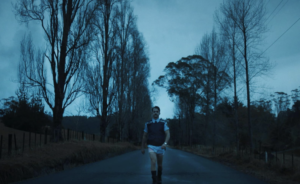
DEAD 2020
Tell me about Undertow (2009).
Undertow is a Peruvian ghost story. There’s a man whose wife is pregnant but he’s also in the closet and having a secret affair with a photographer. The photographer dies, and his ghost comes back and the only person who can see him is his former lover. It’s a heartbreaker. Bring Kleenex. Cristian Mercado and Manolo Cardona are big stars in Peruvian cinema, and both are straight guys who totally go for it. I’m evangelizing about Undertow everywhere.

UNDERTOW (2009)
How about Children Shouldn’t Play with Dead things (1972)?
It’s about a theater troupe on an island, and they dig up a dead body as a prank. There are two gay members of the theater company. Nobody remarks on the fact that they’re gay, they’re accepted. As a young gay theater person horror movie lover, those two characters were literally me, and it was the first time I saw myself onscreen. Not just in a horror movie, but in any movie! This one is very personal for me, but it belongs in the book regardless. It has a great pedigree, with director Bob Clark, who did Black Christmas.
“Seeing yourself” onscreen makes me think of your thoughts on the fellatio moment in The Shining (1980). I felt the hurt in your writing.
And it’s in a movie I really enjoy. I own a copy of every Stephen King book. King is a genius at his craft and if that’s what he wants to write that’s what he wants to write. But that 15 seconds of film is emblazoned in my mind. I was a kid, and I was so excited to see gay people! It wasn’t until later I realized they were being presented as disgusting. The two terrible things happening in that hotel were an elevator emptying blood into a hallway and gay sex.
You included Bergman’s The Hour of the Wolf (1968) and wrote, “Horror is better for geniuses like Bergman’s participation.” Is there a feeling in the horror community that a director who doesn’t normally do horror might be “slumming” when they direct one?
Let’s not be gatekeepers. People get to make the movies they want to make. You can tell, though, when someone’s being mercenary about it. But somebody like Bergman wasn’t slumming. He was investigating horror through his particular genius lens, and we should encourage that. Eli Roth’s Thanksgiving is a slasher movie and nothing more and I had the best time when I saw it in the theatre. But we should also demand more, we should beg for the William Friedkins of the world to make a gay horror movie, or Bergman doing a fever-dream take on guilt and lust. I’m all for it. If we stuck to who was “allowed” to make horror movies, we wouldn’t have a gay horror genre.
What did you mean by “scholarly overreach” in the Psycho entry?
Psycho (1960) has been strip-mined for meaning. There is a point of view that puts Norman Bates on the queer spectrum in a way the source novel and film doesn’t support. The fact that he wears a dress and kills people doesn’t make him trans or queer. It makes him a dissociative psychopath. People desperately want Norman Bates to be gay and I just don’t think he is. Cross-dressing is considered a queer phenomenon or fetish, and killer-in-a-dress is a sub-genre, so that’s why Psycho is in the book. Not because Norman Bates, to my mind, is gay or trans.
I love how you included short films and student films.
And films like the unfinished The Death of P’Town (1963). I loved when a writer wrote a long entry on a movie nobody’s ever heard of that was made for 5 dollars. Because that’s what I want to read! I don’t want to read yet another analysis of Nightmare on Elm St, Part 2. Talk about a movie that’s been strip-mined. I wanted this book to lead people off the beaten path. It’s important people have the opportunity to be well-versed in queer horror if they want to be. All eight of us wanted to do the best we could to make that possible.

